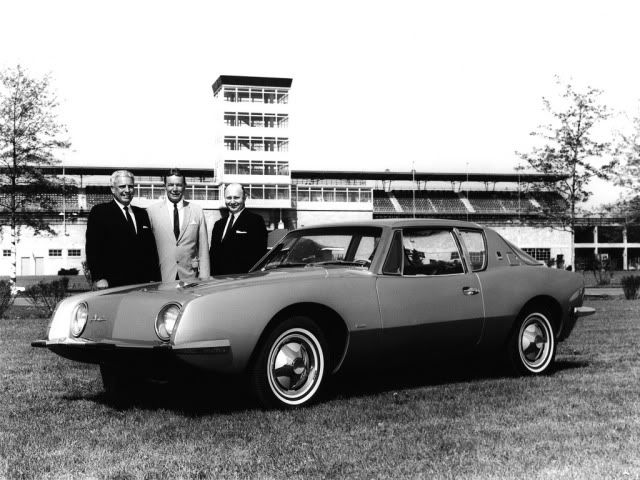Designed within a few weeks on the initiative of Studebaker’s new president Sherwood Egbert, the Avanti creates a sensation due to its innovative styling. Its typical front end does not sport any grille, which forced Studebaker’s engineers to design a special radiator in order to insure proper cooling. To reduce costs, many parts beyond its engine are taken from the Lark: the chassis is modified from a Daytona, the front suspension belongs to the heavy-duty police package, while the rear one comes from the station wagons. It also receives the first disk brakes on any production car built in the United States. Unfortunately, if the Avanti indeed brings attention on its manufacturer, its commercial launch is delayed so much that no car is sold during model year 1962.
Studebaker Avanti
With limited resources, Studebaker has succeeded in presenting a brand new car, its first in ten years. Its premiere is at the New York motor show in April 1962, but production has to wait until June and dealerships sales ultimately do not start within the model year. Loyal designer Raymond Loewy has signed this wedge-shaped coupe, to great extends inspired by a BMW prototype he penned five years ago. Its body is made of fibreglass, and mounted on a modified Lark Daytona chassis. Studebaker having only a limited choice of engines, the Avanti is powered by the largest 4.7-litre one, optionally boosted by a Paxton supercharger. All Avantis also receive bucket seats with a console-mounted gearshift, and front disk brakes - a first in the United States - provided by Bendix, under licence from Dunlop.

● Introduction: April 1962. Construction: body on separate chassis. Engine: water-cooled V-8, 4.7-litre, 240 hp, mounted at the front. Optional engine: supercharged V-8, 4.7-litre, 289 hp. Transmission: to the rear wheels through a three-speed manual gearbox. Four-speed manual and three-speed automatic gearboxes optional. Suspension: independent at the front, rigid axle at the rear. Brakes: hydraulic, to disk on front wheels, drums on rear wheels. Servo optional. Length: 488 cm. Top speed: 225 kph. Range: two-door sport coupe.
Any mistake you’ve just spotted? A detail to add? A suggestion? Don’t hesitate to leave a comment!
Click to jump to another model year of the same car: 1962 – 1963 – 1964
Click here to return to a list of all Studebaker vehicles presented on this blog.
Click here to return to this blog’s initial post, featuring a list of all brands already presented.
Studebaker Avanti
With limited resources, Studebaker has succeeded in presenting a brand new car, its first in ten years. Its premiere is at the New York motor show in April 1962, but production has to wait until June and dealerships sales ultimately do not start within the model year. Loyal designer Raymond Loewy has signed this wedge-shaped coupe, to great extends inspired by a BMW prototype he penned five years ago. Its body is made of fibreglass, and mounted on a modified Lark Daytona chassis. Studebaker having only a limited choice of engines, the Avanti is powered by the largest 4.7-litre one, optionally boosted by a Paxton supercharger. All Avantis also receive bucket seats with a console-mounted gearshift, and front disk brakes - a first in the United States - provided by Bendix, under licence from Dunlop.

● Introduction: April 1962. Construction: body on separate chassis. Engine: water-cooled V-8, 4.7-litre, 240 hp, mounted at the front. Optional engine: supercharged V-8, 4.7-litre, 289 hp. Transmission: to the rear wheels through a three-speed manual gearbox. Four-speed manual and three-speed automatic gearboxes optional. Suspension: independent at the front, rigid axle at the rear. Brakes: hydraulic, to disk on front wheels, drums on rear wheels. Servo optional. Length: 488 cm. Top speed: 225 kph. Range: two-door sport coupe.
Any mistake you’ve just spotted? A detail to add? A suggestion? Don’t hesitate to leave a comment!
Click to jump to another model year of the same car: 1962 – 1963 – 1964
Click here to return to a list of all Studebaker vehicles presented on this blog.
Click here to return to this blog’s initial post, featuring a list of all brands already presented.
No comments:
Post a Comment